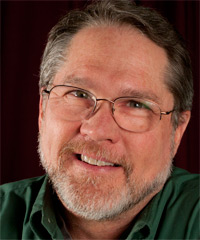Dr. Howard Johnson
Who is he, and why is this Collection being released?
 You already know Dr. Johnson through his many product developments that have affected your life.
You already know Dr. Johnson through his many product developments that have affected your life.
- If you use voicemail, he was among the first to invent that.
- Gigabit LAN networks? Made the first transceivers.
- Ethernet? He was integral to the development of that standard.
- Robotic vehicles? Yup, that too.
As an independant consultant, Dr. Johnson has served literally hundreds of companies, from top names like Google, Amazon, Intel, Microsoft, Hewlett-Packard, AT&T, Cisco, Apple, Raytheon, and Lockheed-Martin, to tiny startups in remote locations. The common thread in all his assignments is to seek out the new, the untried, the never-been-attempted idea and make it work.
If you want to learn something of his spirit, if you want to master the art of high-speed digital design, then watch his seminar courses available now in The Collection. These are the same courses he taught at Oxford University and other sites worldwide over a period of 20 years to over 12,000 students, without question the most successful (and valuable) courses in the field every created.
Now in retirement, Dr. Johnson wishes you well in all your endeavors. He hopes you watch his courses, read his articles, and learn a great deal from them. He now lives on a ranch high up in the Cascade Mountains, on the dry, sunny side of eastern Washington State, where he and his family host the annual Methow Valley Chamber Music Festival. He plays upright bass in a jazz trio in the town of Twisp on weekends, where his mates on the bandstand call him The Good Doctor and where, if you drop by to say hello, he might just buy you a beer.

Read more about Dr. Johnson's life and his mentor, Dr. Martin Graham:
Career Highlights
- Phonemail (1980), the first integrated voice messaging system, started a revolution in telecommunication technology. Dr. Johnson conceived Phonemail years before the general public became aware of personal computer technology. He developed the speech compression algorithms that made it work, built the speech compression prototype, and wrote the plan for hooking it up to a telecommunications system. Thirty years later, everybody uses voicemail, and most voicemail products still use digital speech compression, disk storage, and a keypad-driven interface, just like the original Phonemail.
- Fast Fourier Transform (FFT) algorithms, integral to many digital signal processing methods, sometimes require specialized FFT modules, called prime-length modules, carefully crafted for maximum performance at a specific length. Dr. Johnson (1982) created the fastest known FFT modules for lengths 17, 19, and 25.
- ROLM Corp. (1984), later purchased by IBM, was among the first companies to implement a totally digital telephone system. The internal dataswitching architecture for their largest telephone switch, serving 4,000 or more users, was designed by Dr. Johnson along with his mentor, Martin Graham.
- Flexible Manufacturing Systems (1985), the first company to market a free-moving robotic vehicle, used navigation and control software developed by Dr. Johnson.
- Ultra Network Technologies (1989), makers of the first gigabit local area network, used transceiver technology developed by Dr. Johnson.
- Echelon LONWORKS (1990), a technology for communication over ordinary power lines, was developed in part based on early research and development conducted at the company by Dr. Johnson.
- Ascend Corporation (1991), made Internet point-of-presence routers, connecting ordinary citizens to the Internet for the first time. Dr. Johnson was among the early staff and helped attract key engineers to the company.
- Signal Integrity, an interdisciplinary field of study combining electrical engineering, basic physics, and computer science, did not properly exist before the 1993 release of Dr. Johnson's classic book, High-Speed Digital Design: a Handbook of Black Magic. That book and its sequel, High-Speed Signal Propagation, have together sold approximately 100,000 copies.
- Ethernet, the ubiquitous computer communications standard, now connects nearly all computer systems. Approximately 450 engineers worldwide participated in the Ethernet standards process. Out of those, Dr. Johnson was elected in 1994 to serve as Chief Technical Editor for Ethernet Standards. In that capacity, working alongside Geoff Thompson and Howard Frazier for six years in the IEEE committee structure, Dr. Johnson's technical expertise helped create the Ethernet technology at 100 and 1000 Mb/s that we know today.
- Oxford University, an institution that is constantly looking for new fields of study, selected Dr. Johnson in 1994 to lead the development of a series of annual summer engineering seminars at the University. He took those seminars around the world for the next twenty years, educating over 12,000 students from all corners of the globe. The program at Oxford today enjoys a stable of four very capable instructors teaching courses in diverse areas of High-Speed Digital Engineering.
- EDN Magazine tapped Dr. Johnson to write the popular column, "Signal Integrity," which ran continuously from 1997–2013 in 204 installments. That column introduced the subject of signal integrity, with humor and grace, to engineers worldwide.